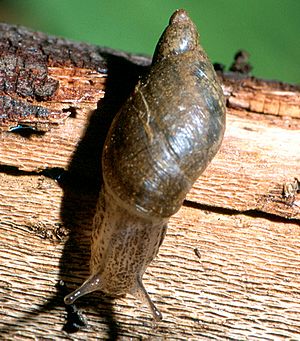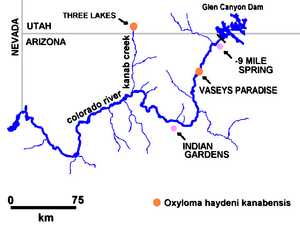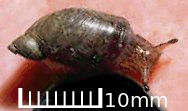Kanab ambersnail facts for kids
Quick facts for kids Kanab ambersnail |
|
|---|---|
 |
|
| A Kanab ambersnail at Vasey's Paradise in Grand Canyon National Park. | |
| Conservation status | |
| Scientific classification |
|
| Kingdom: | Animalia |
| Phylum: | Mollusca |
| Class: | Gastropoda |
| Subclass: | Heterobranchia |
| Clade: | Euthyneura |
| Order: | Panpulmonata |
| Clade: | Eupulmonata |
| Clade: | Stylommatophora |
| Family: | Succineidae |
| Genus: | Oxyloma |
| Species: |
O. haydeni
|
| Subspecies: |
O. h. kanabense
|
| Trinomial name | |
| Oxyloma haydeni kanabense Pilsbry, 1948
|
|
 |
|
| Habitat of the Kanab ambersnail (marked in orange) |
|
| Synonyms | |
|
Oxyloma kanabense Pilsbry, 1948 |
|
The Kanab ambersnail (scientific name: Oxyloma haydeni kanabense or Oxyloma kanabense) is a very small, air-breathing land snail. It is a type of mollusc in the family Succineidae, known as amber snails. These snails get their common name from their shells. When empty, the shells are clear and often look like the color of amber.
This special snail lives only in the United States, mainly in Arizona and Utah. Scientists first found it in the early 1900s. Since 1991, it has been listed as an endangered species by the United States Fish and Wildlife Service. This means it is at high risk of disappearing forever. In 2020, there was a proposal to remove the Kanab ambersnail from this list. This was based on new scientific ideas about whether it is a separate species.
The Kanab ambersnail lives in wet areas like wetlands and springs. Only two natural places where it lives are known. These are Three Lakes, a wet meadow near Kanab, Utah, and Vasey's Paradise. Vasey's Paradise is a group of springs along the Colorado River in Grand Canyon National Park. The snail eats many different things, mostly bacteria, plants, and fungi. It lays eggs and has its young during the summer months.
Because of different problems, including human activities, the Kanab ambersnail is now considered Critically Endangered on the IUCN Red List of Threatened Species. To help save it, some snails have been moved to three new springs along the Colorado River. These new homes are above the usual water level.
Contents
Discovering the Kanab Ambersnail

The first Kanab ambersnails were found in 1909 by James Ferriss. He found them near Kanab, Utah, on a wet rock ledge among moss. At first, people thought these snails were a different species called Succinea hawkinsi.
Later, in 1948, a scientist named Pilsbry moved these snails to the Oxyloma group. He named them Oxyloma haydeni kanabense, calling them a subspecies. A subspecies is like a special type within a larger species. Pilsbry himself thought that more study was needed to be sure about its classification.
Since then, some scientists have suggested that the Kanab ambersnail might be a full species on its own. However, until more clear rules are set, it is still often called by its original name, Oxyloma haydeni subspecies kanabensis.
What Does the Kanab Ambersnail Look Like?
The Kanab ambersnail is a land snail that belongs to the Succineidae family. Its empty shell is a light amber color. When the snail is alive, its shell can be mottled (spotty) grayish-amber to yellowish-amber.
The shell spirals to the right. It has thin walls and a raised tip called a spire. The opening of the shell is wide and expanded. Fully grown snails are about 14 to 19 millimeters (0.5 to 0.75 inches) long. They are 7 to 9 millimeters (0.25 to 0.33 inches) wide. Their shells have about 3.25 to 3.75 spirals.
The snail's eyes are on the ends of long stalks. Its tentacles are very small bumps at the bottom of these eye stalks.
Ecology of the Kanab Ambersnail
Natural Predators
The Kanab ambersnail has a few natural enemies. These include birds like the American robin. Small mammals like deer mice also hunt and eat these snails.
Habitat

The Kanab ambersnail lives in specific wet places. In 1996, a flood destroyed about 16% of the snail's home at Vasey's Paradise. An even bigger flood in 1994 likely caused more damage.
Three Lakes, a private wet meadow near Kanab, Utah, is one of only two natural homes for this snail. This habitat is at risk from new buildings and other development by the owner, Best Friends Animal Society. The other main habitat is Vasey's Paradise in the Grand Canyon. This population is threatened by water released from the Glen Canyon Dam. These releases can wash the snails and their homes downstream.
Even though these snails breathe air, they can survive in cold, oxygen-rich water for up to 32 hours. This ability might have helped them spread around the Colorado Valley. This happened after some snails were purposely released in 1998.
Feeding Habits
Kanab ambersnails are usually found on certain plants. Their favorite host plants are the scarlet monkeyflower (Erythranthe cardinalis) and watercress (Nasturtium officinale). They also live on sedges and rushes.
The snails eat different parts of plants. They also feed on fungi, algae, and bacteria. They use a special scraping tongue called a radula to get their food.
Life Cycle and Reproduction
Like all land snails that breathe air, ambersnails are hermaphroditic. This means each snail has both male and female reproductive parts. Scientists believe they can even fertilize themselves.
In the wild, these snails usually live for about 12 to 15 months. Young snails become inactive during the colder months, from October to November. They become active again in March and April. Adult snails reproduce during the warm summer months.
Population and Conservation
Only two wild groups of Kanab ambersnails are known to exist. These are at Three Lakes near Kanab, Utah, and at Vasey's Paradise. The Vasey's Paradise group was only found in 1991 during a survey. There used to be a third group in Kanab, Utah. However, it is believed to have disappeared because its habitat was destroyed.
Conservation Efforts
In November 1991, the United States Fish and Wildlife Service suggested listing the Kanab ambersnail as endangered. It was officially added to the United States Fish and Wildlife Service list of endangered mammals and birds in April 1992.
The Kanab ambersnail is currently listed as Critically Endangered on the IUCN Red List of Threatened Species. This is the highest risk category.
To help the snails, scientists have released them into new areas. These reintroduction efforts have taken place at three spots along the Colorado River. Each time, 150 snails were released. The first release was in September 1998. These new sites were chosen to be high enough to avoid floods from the dam. A second release happened in July 1999 to increase the number of snails and improve their genetic variability. So far, only one of these new sites, called Upper Elves Chasm, has a new, growing population.
Delisting Proposal
In 2013, a report by the United States Geological Survey suggested that the Kanab ambersnail might not be a separate species based on its genes. Because of this, in January 2020, the Fish and Wildlife Service proposed removing the Kanab ambersnail from the list of endangered species. This proposal was based on a "taxonomic error," meaning they thought it might have been wrongly classified as a distinct species.
Images for kids






